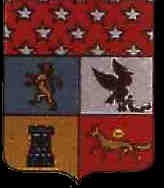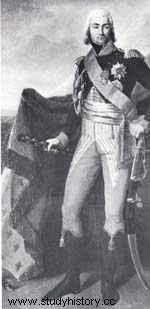August 6, 1768 (Prayssac) - May 1, 1813 (Rippach)
-

- Arms of Bessieres
The son of a barber surgeon, he began his military career, sent by his fellow citizens to Louis XVI's constitutional guard in 1791, which he tried to defend during the attack on the Tuileries.
Having joined the revolutionary armies, he distinguished himself at the battle of Rivoli and was appointed major there. He participated in the siege of Saint-Jean-d'Acre (1799) and the battle of Aboukir in Egypt.
Jean-Baptiste Bessières distinguished himself in the army of the Pyrenees and earned his ranks of lieutenant and captain before moving to Italy with the 22nd Chasseurs and serving under Bonaparte as head of the corps des guides. In the battle of Roveredo, with six of his hunters, he captured two cannons from the enemy.
Egypt, Marengo, Austerlitz, Jena, Eylau
After having accompanied Bonaparte during the Egyptian campaign, Bessières participated in the Coup d'Etat of 18 Brumaire by providing close protection for Bonaparte, which earned him the appointment of second in command of the Consular Guard.
-

- Géraud-Pierre-Henri-Julien Bessières, Knight
On June 14, 1800, Bessières charged during the Battle of Marengo. Promoted to general of brigade a month later, then general of division in September 1802 and Marshal of the Empire in May 1804, Bessières commanded the cavalry of the Imperial Guard when Napoleon marched on Austria and, at Austerlitz, on December 2, 1805, he leads the legendary charge of Chasseurs and Mounted Grenadiers of the Guard which overthrows the Russian Imperial Guard.
The following year, on October 14, Bessières took part in the Battle of Jena, and in February 1807, at the Battle of Eylau, in the midst of a terrible snowstorm, he led the formidable and bloody attack of 80 French squadrons. which break through the Russian lines.
Medina del Rio Seco, Wagram, Russia...
In 1808, Bessières left for Spain and, with the participation of General Lasalle, won the battle of Medina del Rio Seco, July 14, 1808.
Recalled by the Emperor for the war against Austria, he crushed the enemy cavalry at Landshut on April 21, 1809 and took part in the murderous battles of Essling and Wagram, where his horse was killed under him.
Duke of Istria in May 1809, he spent a few months in Spain in 1811, where he was responsible for the loss of Portugal for having refused to support Masséna against Wellington
Bessières joined the Grande Armée in Russia in 1812. His main feat of arms was the clearing of the Emperor's headquarters, attacked by 8,000 Cossacks in Maloiaroslavets, on October 24 and 25, 1812.
Carried away by a ball
In 1813, when the Saxon campaign began, the Emperor entrusted him with all the cavalry of the army. But on May 1, 1813, on the eve of the Battle of Lützen, while leading an attack near Weissenfells, a ball shattered his hand and pierced his chest. . His name is inscribed on the Arc de Triomphe de l'Etoile, on the east side.
Timeline
 1768
1768
- June 6:Born in Prayssac (Lot)
 1788
1788
- Writes down the grievances of his municipality
 1791
1791
- Sent to the Constitutional Guard of Louis XVI
 1792
1792
- In April:Joined the Constitutional Guard of Louis XVI
- June 5:Licensed
- November 1:Joins the 22nd Chasseurs à Cheval Regiment
 1797
1797
- January 14:Stands out at the Battle of Rivoli
 1798
1798
- March 9:Squad Leader
 1799
1799
- March 19 to May 20:Participates in the siege of Saint-Jean-d'Acre
- July 25:Take part in the victory of Aboukir
 1800
1800
- June 14:Charge at Marengo
- In July:Promoted to Brigadier General
 1802
1802
- September 13:Appointed Major General
 1804
1804
- May 19:He is made Marshal of the Empire
 1805
1805
- March on the Austrian army at the head of the cavalry of the guard
- December 2:Charge at Austerlitz
 1806
1806
- November 14:Participates in the Battle of Jena
 1807
1807
- February 8:Participates in the Battle of Eylau
 1808
1808
- Departs for Spain to occupy Salamanca
- July 14:Win Medina del Rio
 1809
1809
- April 21:Crushes the Austrian cavalry at Landshut
- In May:He is made Duke of Istria
 1811
1811
- Governor in Spain
 1812
1812
- Russian Campaign Leading the Cavalry of the Imperial Guard
- October 24 and 25:Clear the Emperor's headquarters attacked by 6,000 Cossacks in Shorodina
 1813
1813
- Led all the cavalry of the army during the Saxony campaign
- May 1:Killed near Weissenfells by a cannonball
